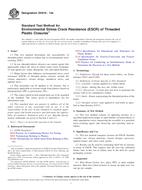We need your consent to use the individual data so that you can see information about your interests, among other things. Click "OK" to give your consent.
ASTM D5419-14a
Standard Test Method for Environmental Stress Crack Resistance (ESCR) of Threaded Plastic Closures (Includes all amendments And changes 9/17/2021).
Automatically translated name:
Standard Test Method for Environmental Stress Crack Resistance (ESCR) of Threaded Plastic Closures
STANDARD published on 1.12.2014
The information about the standard:
Designation standards: ASTM D5419-14a
Note: WITHDRAWN
Publication date standards: 1.12.2014
SKU: NS-31100
The number of pages: 5
Approximate weight : 15 g (0.03 lbs)
Country: American technical standard
Category: Technical standards ASTM
The category - similar standards:
Annotation of standard text ASTM D5419-14a :
Keywords:
closures, environmental stress crack resistance (ESCR), failure, plastic, stress crack, threaded plastic closures,, ICS Number Code 83.080.20 (Thermoplastic materials)
Additional information
| Significance and Use | ||||||||||||
|
5.1 This test method compares closures for ESCR. Suitable variables are: closure materials, closure designs, processes, applied torque, and stress-crack agents. 5.2 Results can be used for estimating shelf life of closures in terms of ESCR. This requires that the user has calibrated failure time in this test to failure time in the field for actual packaging systems. |
||||||||||||
| 1. Scope | ||||||||||||
|
1.1 This test method determines the susceptibility of threaded plastic closures to failure due to environmental stress cracking (ESC). 1.2 In use, threaded plastic closures can contact agents that appreciably reduce the stress at which cracks form. Examples of such agents are: soaps, detergents, oils, and liquid bleaches. 1.3 Major factors that influence environmental stress crack resistance (ESCR) of threaded plastic closures include the closure material(s), closure design, molded-in stress, and applied stress. 1.4 This procedure can be applied to all closures, but is particularly applicable to closures made from plastics based on polypropylene (PP) or polystyrene (PS). 1.5 The values stated in inch-pound units are to be regarded as the standard. The values given in parentheses are for information only. 1.6 This standard does not purport to address all of the safety concerns, if any, associated with its use. It is the responsibility of the user of this standard to establish appropriate safety and health practices and determine the applicability of regulatory limitations prior to use. Specific precautionary statements are given in Section 8 and 6.2. Note 1: There is no known ISO equivalent to this
standard.
|
||||||||||||
| 2. Referenced Documents | ||||||||||||
|
We recommend:
Updating of laws
Do you want to be sure about the validity of used regulations?
We offer you a solution so that you could use valid and updated legislative regulations.
Would you like to get more information? Look at this page.




 Cookies
Cookies
